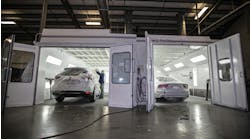Are you doing the same thing that you did when you first started your shop? What makes you different? What sets you apart from your competition? As human beings, we do not like to change, which spills over to our jobs in the collision repair industry. Are you doing everything in your shop to promote change? I deal with many shops throughout a month, and change management is one of the common difficulties I often hear — many need to know how to move their business forward and differentiate their shop from everyone else.
Change management is a collective term for all approaches to prepare, support, and help individuals, teams, and organizations make organizational change. There is no one-size-fits-all approach to change management. Change management helps ensure that any change your organization implements will be done thoroughly and as smoothly as possible to achieve the desired outcome. You must be willing to embrace change to set yourself apart in an industry that, on the surface, is alike in a lot of ways. Collision shops that welcome change to meet the increasing demands of consumers will shift from just getting by to a company that can tackle anything — and succeeds. I would like to talk about some ideas that will help you when you are looking to set your shop apart from everyone else in the marketplace.
In my research for this article, I found that you must rely on a few change management principles to enact positive change in your business. The first principle is that you and your organization must understand the evolution and why this needs to happen. What are the objectives that you want to achieve with the change? Do you want to change the way you do marketing? Are you going to get certified with one or more manufacturers? Have you considered changing the way you document the repair process? These questions will affect the next step in this process. Will this change have a positive or negative impact on your strategy? What will be the impact on the profitability of your company? How will this affect your employees’ morale and work-life balance? What steps need to be taken to change successfully? Answering these questions that I pose to you will help your organization take the steps necessary to evolve effectively.
You do not want to fall into a trap of implementing something just because it works best for another company or because an industry leader we took a class from tells us that it will work. Folks, I want you all to remember that every business is different. Every collision repair shop is different in how they deal with their customers. What works in one geographic area may not work in another. We must make sure that we understand this fact.
The second principle to successful change management is that you must plan the change. Without a proper plan, you do not know which direction to go and if you will ever arrive at your goal. You aimlessly wander through the motion, never achieving what you want to accomplish. A plan must include a “buy-in” from all relevant parties in the organization. Every shop has that one technician that influences everything in their shop. If he or she is onboard, then everyone else will be.
The third principle of successful change management is you must implement the change. This step makes sure that everyone involved in the changes, whatever it may be, understands what is expected of them and what needs to be done. It is also a step that many people often have trouble with, because, as owners and managers, we just put something out there and expect everyone to understand it. You may have to include training to help them understand. As an owner or manager, recruiting change agents, which are influential employees, can help move the change forward. The third principle of change management is critical to the business’s success because it is where the habits are formed.
The fourth and last principle of successful change management is effectively communicating the change throughout the shop. Communication is an area that our industry that needs a lot of work. We do not communicate well, and this means with each other and the customer. Effective communication will benefit everyone in the industry. Most importantly, it will help the customer. Our industry is on a collision course to change how we communicate with customers or risk being irrelevant in the industry. We must educate ourselves and our customers on the proper way to repair a vehicle correctly. Our main goal is to provide a complete, safe, and quality repair. We must remember that we are working with our customers during a trying time in their life typically and we must help them understand the difference between all the choices in the industry. My question is: are you doing what it takes to promote your business and making it different from everyone else in the industry? Are you doing what it takes to be relevant in our ever-changing industry? Be sure and join me next time for more thoughts, and please let me know what your facility is doing to differentiate yourself from everyone else.




